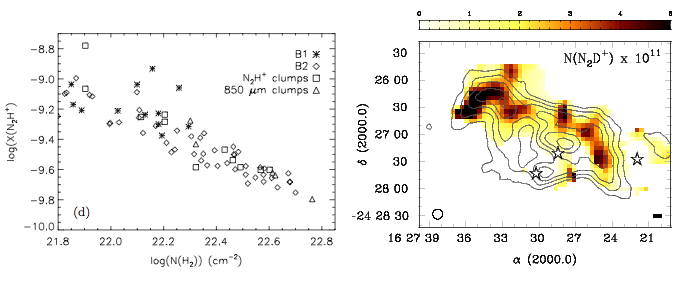| EPoS Contribution |
|
The Distribution of Dense Gas and Deuterium Fractionation in Ophiuchus B
Rachel K. Friesen National Radio Astronomy Observatory, Charlottesville, USA | |
| Systematic observations of multiple molecular species have greatly enhanced our understanding of the density, temperature, velocity and abundance profiles of starless and protostellar cores in isolation. These studies are necessary to follow the evolution of dense gas to star. With the goal of characterizing the physical conditions of dense gas in cluster-forming environments, we present the results of mapping of expected dense gas tracers (including NH3, N2H+, N2D+ and H2D+) towards the low-mass, stellar group-forming Ophiuchus B Core. We find strong evidence that NH3 and N2H+ do not trace the coldest and densest locations of the core, including significant offsets between objects identified in continuum emission and in NH3 and N2H+ (in contrast with typical good correspondence found in isolated regions), relatively low fractional NH3 and N2H+ abundance at the positions of continuum objects, and a general trend of decreasing fractional abundance of both species with increasing H2 column density. Distributions across Oph B2 of the deuterated species N2D+ and H2D+ follow more closely the continuum emission, but we find no abundance trend with column density or gas temperature. We find, however, an anticorrelation in deuterium fractionation with proximity to embedded protostars, suggesting that even low-mass protostars can significantly impact the chemistry of larger-scale, cluster-forming cores. | |
 | |
| Caption: N2H+ abundance as a function of H2 column density in the Oph B core, showing the decreasing abundance trend with increasing N(H2). Right: N2D+ column density in Oph B2 (colour scale) overlaid with 850 micron continuum contours and with locations of Class I protostars identified. Despite finding no clear evidence of increased gas temperature as traced by NH3, little deuterated N2H+ is found near the protostars or continuum peak. | |
| Collaborators: J. Di Francesco, NRC-HIA, Canada P.C. Myers, Harvard CfA, USA P. Andre, CEA/SAp Saclay, France A. Belloche, MPIfR, Germany Y.L. Shirley, U. Arizona, USA T.L. Bourke, HSCfA, USA |
Key publication
Suggested Session: Chemistry, Cores and Collapse |

